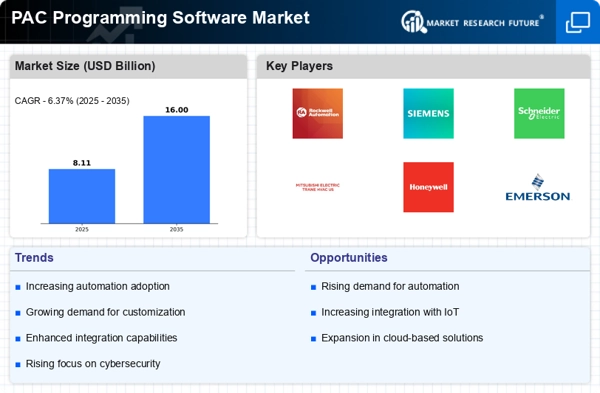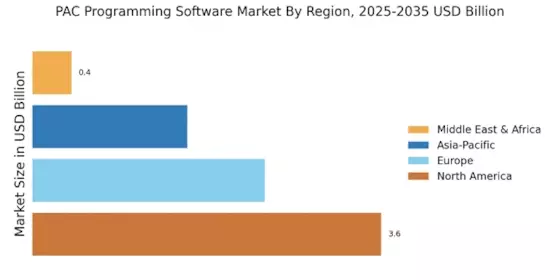The PAC Programming Software Market is currently characterized by a dynamic competitive landscape, driven by rapid technological advancements and increasing demand for automation across various industries. Key players such as Rockwell Automation (US), Siemens (DE), and Schneider Electric (FR) are strategically positioned to leverage their extensive portfolios and innovative capabilities. Rockwell Automation (US) focuses on integrating advanced analytics and AI into its software solutions, enhancing operational efficiency for clients. Siemens (DE) emphasizes digital transformation through its MindSphere platform, which connects industrial devices to the cloud, thereby facilitating data-driven decision-making. Schneider Electric (FR) is committed to sustainability, promoting energy-efficient solutions that align with global environmental goals. Collectively, these strategies not only enhance their competitive edge but also shape the market dynamics by fostering a culture of innovation and collaboration.
In terms of business tactics, companies are increasingly localizing manufacturing and optimizing supply chains to respond swiftly to market demands. The PAC Programming Software Market appears moderately fragmented, with a mix of established players and emerging startups. This structure allows for diverse offerings and competitive pricing, yet the influence of key players remains substantial, as they set industry standards and drive technological advancements.
In August 2025, Rockwell Automation (US) announced a partnership with a leading AI firm to develop predictive maintenance solutions for manufacturing environments. This strategic move is likely to enhance Rockwell's product offerings, enabling clients to minimize downtime and optimize production processes. The integration of AI into their software solutions could position Rockwell as a frontrunner in the market, appealing to manufacturers seeking to leverage data for operational improvements.
In September 2025, Siemens (DE) launched a new version of its TIA Portal, which incorporates enhanced cybersecurity features and improved user interfaces. This development is significant as it addresses growing concerns regarding industrial cybersecurity, thereby reinforcing Siemens' commitment to providing secure and reliable automation solutions. The upgrade not only strengthens Siemens' market position but also aligns with the increasing regulatory focus on cybersecurity in industrial applications.
In July 2025, Schneider Electric (FR) unveiled its EcoStruxure platform, which integrates IoT capabilities to optimize energy management in industrial settings. This initiative reflects Schneider's strategic focus on sustainability and energy efficiency, catering to the rising demand for environmentally friendly solutions. By enhancing its platform with IoT functionalities, Schneider Electric is likely to attract a broader customer base, particularly those prioritizing sustainability in their operations.
As of October 2025, the PAC Programming Software Market is witnessing trends such as digitalization, sustainability, and AI integration, which are reshaping competitive dynamics. Strategic alliances among key players are becoming increasingly prevalent, fostering innovation and enhancing product offerings. Looking ahead, competitive differentiation is expected to evolve, with a shift from price-based competition to a focus on innovation, technology, and supply chain reliability. Companies that can effectively integrate these elements into their strategies are likely to thrive in this rapidly changing landscape.


















Leave a Comment